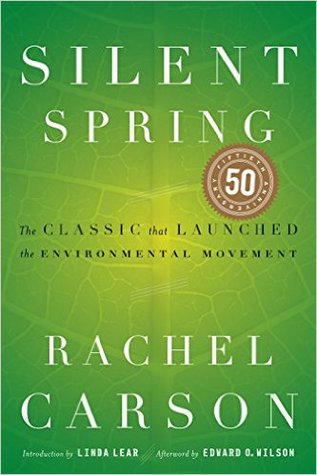More on this book
Community
Kindle Notes & Highlights
“Man has lost the capacity to foresee and to forestall. He will end by destroying the earth.”
no birds sing.
Our approach to nature is to beat it into submission. We would stand a better chance of survival if we accommodated ourselves to this planet and viewed it appreciatively
a list of my principal sources of information,
found at the back of the book. R.C.
Olga Owens Huckins
her own bitter experience of a small world made lifeless,
a problem with which I had long be...
This highlight has been truncated due to consecutive passage length restrictions.
L. G. Bartholomew, M.D.,
Morton S. Biskind, M.D.,
George Crile, Jr., M.D.,
Malcolm M. Hargraves, M.D.,
W. C. Hueper...
This highlight has been truncated due to consecutive passage length restrictions.
National Cancer I...
This highlight has been truncated due to consecutive passage length restrictions.
the people who first spoke out against the reckless and irresponsible poisoning of the world
thousands of small battles that in the end will bring victory for sanity and common sense
national debate on the use of chemical pesticides, the responsibility of science, and the limits of technological progress.
Carson died barely eighteen months later in the spring of 1964, at the age of fifty-six,
Carson’s writing initiated a transformation in the relationship between humans and the natural world
we were subjecting ourselves to slow poisoning by the misuse of chemical pesticides
In postwar America, science was god, and science was male.
her chosen field, biology, was held in low esteem in the nuclear age.
Rachel Carson first discovered nature in the company of her mother, a devotee of the nature study movement.
Allegheny River in the pristine village of Springdale, Pennsylvania, just north of Pittsburgh,
A dynamic female zoology professor expanded her intellectual horizons by urging her to take the daring step of majoring in biology rather than English.
Woods Hole Biological Laboratory, where she fell in love with the sea,
Carson realized that she did not have to
choose between science and writing, that she had the talent to do both.
She was an ecologist—fascinated
whole—before that perspective was accorded scholarly legitimacy.
her first book, Under the Sea-Wind
sanderling,
the search for food, involves an arduous journey from Patagonia t...
This highlight has been truncated due to consecutive passage length restrictions.
her “kinship with other for...
This highlight has been truncated due to consecutive passage length restrictions.
The little town of Springdale, sandwiched between two huge coal-fired electric plants, was transformed into a grimy wasteland,
Carson could not wait to escape.
The experience made her forever suspicious of promises of “better living through chemistry”
She signed her articles “R. L. Carson,” hoping that readers would assume that the writer was male and thus take her science seriously.
junior aquatic biologist for the Bureau of Fisheries,
which became the U.S. Fish and Wildlife Service in 1939.
By 1949 Carson was editor in chief of all the agency’s publications,
The Sea Around Us
National Book Award for nonfiction,
The Edge of the Sea,
made Rachel Carson the foremost science writer in America.
Hers was a trusted voice in a world riddled by uncertainty.
“[mankind] seems to be going farther and farther into more experiments for the destruction of himself and his world.”
In 1945 she tried to interest Reader’s Digest in the alarming evidence of environmental damage from the widespread use of the new synthetic chemical DDT and other long-lasting agricultural pesticides.
“There would be no peace for me,” she wrote to a friend, “if I kept silent.”
Carson described how chlorinated hydrocarbons and organic phosphorus insecticides altered the cellular processes of plants, animals, and, by implication, humans.


